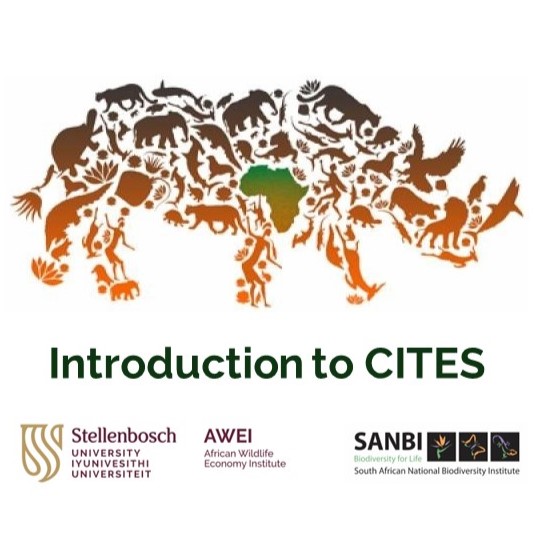CITES Module 5
5 CITES and its appendices
In this module you will learn about the aims and structure of the Convention on International Trade in Endangered Species of Wild Fauna and Flora (CITES) with a focus on its appendices.
Lecture
-
Click on the image below to stream the lecture on OneDrive (10 min)
-
You can also download the lecture for listening offline
-
Take notes while listening
CITES
Aims to ensure that international trade in wild animals and plants is
- legal,
- sustainable,
- traceable, and
- does not threaten the survival of the species in the wild
It covers
- export,
- re-export,
- import, and
- landing from the high seas
of
- live and dead animals,
- live and dead plants, and
- their parts and derivatives
CITES Appendices
- Appendix I - wild species in danger of extinction due to international trade
- Appendix II - wild species for which trade must be controlled to prevent future endangerment.~
- Appendix III - wild species protected at the request of a specific Party (country) that regulates their trade.
Learning resources - videos
-
While watching these videos, reflect on the learning questions provided
-
Take notes while viewing
African Union Conference Welcome & Opening Remarks by CITES Secretary-General Ivonne Higuero
- Opening remarks at the African Union Conference on the Implementation of CITES CoP19 and CBD CoP15 Outcomes
- Q: What are some linkages between CITES and CBD COP outcomes?
CITES 101
- This video was produced in cooperation with DOI-ITAP, the CITES Secretariat, and the U.S. State Department, with the purpose of disseminating an overview of best practices to help prevent the illegal wildlife trade.
- Q: If a species is listed on a CITES Appendix, is trade prohibited? If not, what is required to enable a trade?
 Learning resources - readings
Learning resources - readings
-
While skimming through these documents, reflect on the learning questions provided
-
Also, download documents for future reference
- Annually, over 1 million CITES permits and certificates are issued by Parties covering international wildlife trade estimated to be worth billions of dollars and to include hundreds of millions of plant and animal specimens. The trade is diverse, ranging from live animals and plants to a vast array of wildlife products derived from them, including food products, exotic leather goods, wooden musical instruments, timber, tourist souvenirs, cosmetics and medicines.
- Q: Can you name 5 CITES-listed wildlife products that are exported legally from South Africa?
Chapter on CITES in International Export Regulations and Controls (WTO, 2023)
- As an international agreement, CITES is legally binding on the states parties and provides a set of common minimum standards for international trade in the specimens of species regulated by it. These need to be complemented by national legislation to ensure that the provisions can be applied and enforced at the national level by the designated CITES management authorities and mandated enforcement agencies, such as the police and customs authorities.
- Q: How are CITES and WTO connected?
Summary of the 19th Meeting of the CITES Conference of the Parties: 14-25 November 2022
- The meeting of the Conference of the Parties (CoP) of the Convention in International Trade in Endangered Species of Wild Fauna and Flora (CITES) took place at a critical moment, as several recent scientific reports and articles have underscored the urgency of halting, and reversing, biodiversity loss, with overexploitation highlighted as one of the main threats to wild plants and animals together with habitat loss and climate change.
- Q: Are more listings on Appendices good news for conservation or bad news?
Legal and sustainable wild species trade
- This paper, conducted by the Taskforce on Nature Markets in collaboration with TRAFFIC, explores nature as an emerging market that is increasingly monetised. It focuses on the necessary governance and financial sector structures that must be built to promote legal, sustainable, and transparent nature markets.
- Q: Which of the 15 building blocks identified could support the aims of CITES?
 Learning resources - websites
Learning resources - websites
-
While browsing these websites, reflect on the learning questions provided
-
Also, bookmark websites for future reference
- The website of the convention
- Q: Can you find news or details on recent legal trade in African listed species?
- CITES works by subjecting international trade in specimens of selected species to certain controls. All import, export, re-export and introduction from the sea of species covered by the Convention has to be authorized through a licensing system.
- Q: What is the role of the Scientific Authority in CITES?
- Species may be added to or removed from Appendix I and II, or moved between them, only by the Conference of the Parties
- Q: Can one see when a species was added or removed and why?
South Africa on the CITES website
- The purpose of the country profiles is to place all information in one place that concerns each Party, including on designated authorities, reports, reservations, registers, exemptions and special procedures, stricter domestic measures and compliance status
- Q: Does the South African profile provide information on how to secure a CITES export permit?
UK CITES Scientific Authority for Flora
- Each country signed up to the Convention designates a Management Authority and a Scientific Authority... The UK Scientific Authorities are Kew for plants and the Joint Nature Conservation Committee (JNCC) for animals.
- Q: How does the UK's Scientific Authroity provide information to traders and other interested stakeholders?
Let's continueGo to Module 6 CITES trade measuresGo back to Module 4Go back to the beginning |
Get updates by email
Through impactful research, stakeholder engagement, and professional development, AWEI is supporting the wildlife economy across Africa. Please subscribe for occasional updates on our work and forthcoming events.
Sign up for a quarterly dose of AWEI insights
In a complex and changing world, AWEI generates strategic ideas, conducts independent analysis on wildlife economies, and collaborates with global scholar-practitioners to provide training and expertise for biodiversity conservation, climate resilience, and inclusive economic opportunities in Africa.

